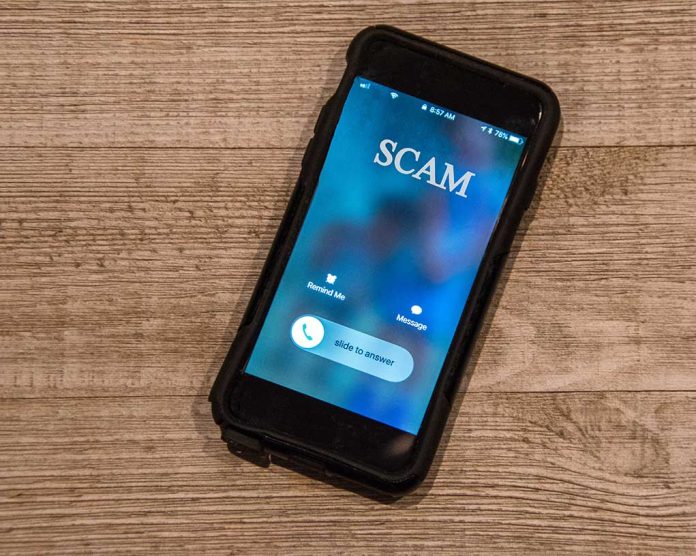
Criminals are preying on Americans’ confusion over President Trump’s new tariff policies, stealing $239 million annually through sophisticated schemes that exploit legitimate economic concerns.
Key Takeaways
- Scammers are creating fake government communications demanding immediate “tariff payments” that can drain victims’ bank accounts
- Criminals commonly impersonate customs officials claiming packages are held due to unpaid tariffs
- Fraudsters leverage the complexity of tariff policies to launch investment scams with fake Trump endorsements
- Legitimate tariffs are collected from importers and businesses, not directly from individual consumers
- Verifying all communications through official government websites can protect you from these increasingly sophisticated scams
Tariff Confusion Creates Perfect Storm for Scammers
As President Trump implements his America First trade policies through strategic tariffs, criminals are capitalizing on public confusion surrounding these economic measures. Scammers have developed multiple schemes targeting confused consumers, from fake government emails demanding immediate tariff payments to counterfeit websites mimicking federal agencies. These criminals exploit both the complexity of international trade policies and current economic anxieties to separate Americans from their hard-earned money through increasingly convincing deceptions.
“SCAMMERS ARE ALREADY CAPITALIZING ON CONFUSION OVER TARIFFS” – said by Jeff Somers.
The psychology behind these scams is calculated and deliberate. Criminals leverage powerful emotional triggers including artificial urgency, fear of consequences, and exploitation of authority figures. By creating scenarios that prevent rational thinking—such as claiming your package will be destroyed unless you immediately pay fabricated tariff fees —these scammers bypass your natural skepticism. Many victims report feeling rushed into decisions they would never make under normal circumstances.
Common Tariff Scam Tactics to Watch For
The most prevalent tariff scam involves fake shipping notifications claiming your package is being held at customs due to unpaid tariffs. These communications often include official-looking logos from USPS, FedEx, or other legitimate carriers. The messages typically contain an urgent deadline and threaten package destruction unless immediate payment is made through untraceable methods like gift cards or cryptocurrency—a major red flag that indicates fraudulent activity.
Another common scheme involves criminals impersonating energy companies claiming that President Trump’s tariff policies have affected utility rates. These scammers demand immediate payment to avoid service disconnection, preying particularly on elderly Americans who may be less familiar with how tariffs actually work. The financial impact of these scams is substantial, with energy fraud alone costing victims hundreds of millions annually according to consumer protection reports.
“Pay now or lose service” according to unknown scammer language
Investment Scams Promising “Tariff-Free” Returns
Perhaps the most financially devastating tariff-related scams involve investment opportunities that supposedly capitalize on President Trump’s trade policies. These schemes often promise tariff-exempt investments or inside knowledge of industries that will benefit from policy changes. Many fraudulently use the President’s name or image to suggest endorsement, targeting conservatives who support his economic agenda. These scams frequently involve cryptocurrencies or foreign exchange markets where transactions are difficult to trace once funds disappear.
The most dangerous aspect of these investment scams is their sophistication. Criminals create elaborate websites with fake testimonials, fabricated historical returns, and counterfeit government certifications. They leverage social engineering tactics that exploit fear of missing opportunities, presenting these investments as once-in-a-lifetime chances that require immediate action. By the time victims realize they’ve been defrauded, their money has typically been moved through multiple accounts and cannot be recovered.
How to Protect Yourself from Tariff Scams
The most critical protection against tariff scams is understanding that legitimate tariffs are collected from importers and businesses, not directly from individual consumers through unexpected payment demands. Government agencies like U.S. Customs and Border Protection never contact individuals demanding direct tariff payments via gift cards, wire transfers, or cryptocurrencies. Any such request is immediately suspect and should be reported to authorities.
“If a deal sounds too good to be true, it probably is—especially when it comes to your energy bill. Always verify the company, never share personal info over the phone, and remember real providers don’t pressure you on the spot.” according to Energy Professional
When receiving communications about packages or products allegedly held for tariff payment, independently verify tracking information directly through the shipping carrier’s official website—never through links provided in suspicious emails or texts. For investment opportunities claiming special knowledge about tariff impacts, consult with licensed financial advisors and verify all credentials through official regulatory websites like the SEC’s Investment Adviser Public Disclosure database.
Finally, report all suspected tariff scams to the Federal Trade Commission at ReportFraud.ftc.gov and to local law enforcement. Your vigilance not only protects your finances but helps authorities track and shut down these criminal operations before they can target other Americans. By staying informed about how tariffs actually work, you can identify and avoid the increasingly sophisticated schemes designed to exploit President Trump’s economic policies for criminal gain.









